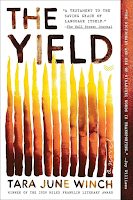For we're always out of luck here. That's just how it is--for instance in the winter. The sides of buildings, the roof, the limbs of the trees are gray. Streets, sidewalks, faces, feelings--they are gray. Speech is gray, and the grass where it shows. Every flank and front, each top is gay. Everything is gray: hair, eyes, window glass, the hawkers' bills and touters' posters, lips, teeth, poles and metal signs--they're gray, quite gray. Cars are gray. Boots, shoes, suits, hats, gloves are gray. Horses, sheep, and cows, cats killed in the road, squirrels in the same way, sparrows, doves, and pigeons, are all gray, everything is gray, and everyone is out of lock who lives here.
William Gass' novella "The Pedersen Kid" is one of those stories--or, I guess, novellas--that stick with you a long time; it chills the blood beyond the effective description of the Midwestern winter, chills it like the kid of the title, found outside the narrator's house in a snowbank nearly dead. The narrator, too, is a child or a teenager, and the sight of the frozen "Pedersen Kid" stripped naked, dead-looking, being rubbed by the family's workman Big Hans, unsettles him. In a brief moment of wakefulness, the Pedersen Kid tells an ambiguous story of a gunman who's trapped his family in their root cellar, where they will surely freeze if they haven't been shot. Together, the narrator, his alcoholic father, and Big Hans go to investigate, and the brutal winter may be as dangerous to them as the gunman.
(OK, a spoiler alert from here on.) Although the gunman is never seen, he does seem to be real: the narrator hears the shooting death of both his father and Big Hans as they crouch outside the Pedersen house in the snowbank. The gunman leaves, but comes back after the narrator slips into the house, and much of the drama of the novella's final third is purely psychological: the narrator never goes into the root cellar to see if the Pedersen family is really there, though his imagination provides what appears to be an essentially impeachable truth. He senses that he and the "Pedersen Kid," recuperating in his own house, have been swapped or traded for one another. Because he and the Pedersen Kid are equivalent, the death of the Pedersen Kid's family precedes and has ensured his own. What the narrator experiences in the house as he waits for the gunman is not, in the end, fear, but joy--he's been freed from the cruelties of his father and the predations of Big Hans, who is subtly suggested to have been sexually abusing the narrator.
It's an astonishing, frightening story. It's united with the other pieces in In the Heart of the Heart of the Country by the motif of the intense Midwestern winter. It's there in "Icicles," a novella about a real estate agent who becomes obsessed with the row of perfect icicles that have formed along his porch. He, Fender, has a boss named Pearson whose maxim is Everything is Property, and whose totalizing aggression reminded me of Shrike in Miss Lonelyhearts. Fender takes Pearson's maxim to heart, which is both affirmed by icicles on his porch--beautiful things which belong to his "property" and thus to him--and threatened by it--because the icicles are fundamentally fragile and liable to be snapped off by warming weather or mischievous children. Like "The Pedersen Kid," "Icicles" is primarily psychological; what "happens" is mostly contained within Fender's mind as he grapples with the possibility that he, too, is property, and yet the evanescent nature of the icicles suggests that might not as assuring or permanent a belief as one might expect.
But I think my favorite is the title piece, an extended description of Gass' hometown of "B," Indiana. Gass describes B and the larger Midwest as a gray and dreary place--you get the sense that it never experiences a season that isn't winter--and yet, in that grayness and dreariness there is much to capture the attention. Gass leaves no room for any cant about rural living--he calls the idea of farmers living close to the land "a lie of old poetry"--but also describes as being far superior to the hot and crowded life of cities, "swollen and poisonous with people." Though the piece--story? novella? essay?--is largely descriptive, it's addressed to a lover whose unexplained absence touches every scene and experience. To me, it's his kind of piece that allows Gass' tremendous verbal capacity to breathe, without getting caught up in the necessities of event and plot. It allows the reader to luxuriate in descriptions of "snow without any laughter in it, a pale gray pudding thinly spread on stiff toast"; and of the slinking cat, "is long tail rhyming with his paws."







